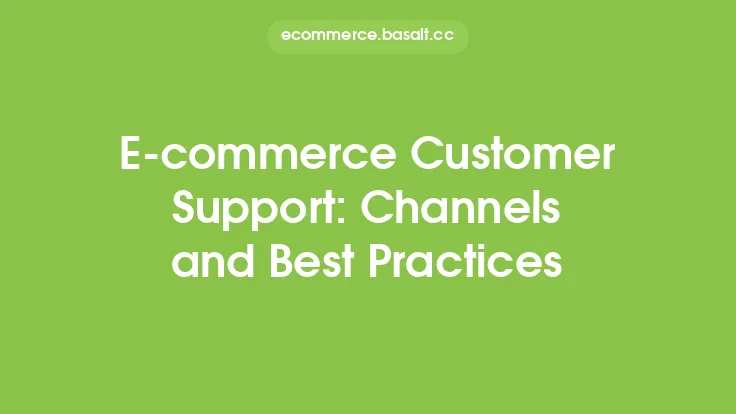The world of e-commerce has undergone a significant transformation in recent years, with the rise of cross-border e-commerce being a key driver of this change. Cross-border e-commerce refers to the practice of buying and selling products or services across international borders, using digital platforms. This trend has opened up new opportunities for businesses to expand their customer base, increase revenue, and tap into new markets. In this article, we will explore the current trends and opportunities in cross-border e-commerce, and what they mean for businesses and consumers alike.
Introduction to Cross-Border E-commerce
Cross-border e-commerce has been growing rapidly in recent years, driven by advances in technology, changes in consumer behavior, and the increasing ease of doing business across borders. According to a report by PayPal, the global cross-border e-commerce market is expected to reach $1.4 trillion by 2025, with an estimated 945 million cross-border online shoppers. This growth is being driven by a number of factors, including the increasing availability of high-speed internet, the rise of mobile commerce, and the growing demand for international products.
Benefits of Cross-Border E-commerce
There are a number of benefits to cross-border e-commerce, both for businesses and consumers. For businesses, cross-border e-commerce provides an opportunity to expand their customer base and increase revenue. By selling products or services across international borders, businesses can tap into new markets and reach customers who may not have been accessible otherwise. Additionally, cross-border e-commerce can help businesses to diversify their revenue streams and reduce their dependence on domestic markets. For consumers, cross-border e-commerce provides access to a wider range of products and services, often at lower prices than those available domestically. Consumers can also benefit from the ability to purchase products that are not available in their home country.
Challenges of Cross-Border E-commerce
Despite the benefits of cross-border e-commerce, there are also a number of challenges that businesses and consumers must navigate. One of the main challenges is the complexity of international trade regulations and laws. Businesses must comply with a range of regulations, including those related to customs, taxation, and product safety. Additionally, businesses must also navigate the challenges of language and cultural differences, as well as differences in consumer behavior and preferences. Consumers, on the other hand, must be aware of the potential risks associated with cross-border e-commerce, including the risk of counterfeit products, fraud, and non-delivery.
Key Trends in Cross-Border E-commerce
There are a number of key trends that are shaping the cross-border e-commerce landscape. One of the main trends is the growth of e-commerce platforms that specialize in cross-border trade. These platforms, such as Alibaba's AliExpress and Amazon's Global Store, provide businesses with a range of tools and services to help them sell products across international borders. Another trend is the increasing use of digital payment systems, such as PayPal and Alipay, which make it easier for consumers to pay for products and services online. Additionally, there is a growing trend towards the use of data analytics and artificial intelligence to help businesses better understand their customers and tailor their marketing efforts accordingly.
Opportunities for Small and Medium-Sized Enterprises (SMEs)
Cross-border e-commerce provides a number of opportunities for small and medium-sized enterprises (SMEs) to expand their business and reach new customers. SMEs can use e-commerce platforms to sell products across international borders, without the need for a large upfront investment. Additionally, SMEs can also use digital marketing channels, such as social media and search engine optimization, to reach new customers and promote their products. However, SMEs must also be aware of the challenges associated with cross-border e-commerce, including the need to comply with international trade regulations and laws.
The Role of Free Trade Agreements (FTAs) in Cross-Border E-commerce
Free trade agreements (FTAs) play an important role in facilitating cross-border e-commerce. FTAs reduce or eliminate tariffs and other trade barriers, making it easier for businesses to sell products across international borders. Additionally, FTAs can also help to simplify customs procedures and reduce the complexity of international trade regulations. However, FTAs can also create new challenges, such as the need to comply with rules of origin and other regulatory requirements.
The Future of Cross-Border E-commerce
The future of cross-border e-commerce looks bright, with the global market expected to continue growing in the coming years. As technology continues to advance and trade regulations evolve, it is likely that cross-border e-commerce will become even easier and more accessible. Additionally, the growth of emerging markets, such as those in Africa and Asia, is expected to provide new opportunities for businesses to expand their customer base and increase revenue. However, businesses must also be aware of the potential risks and challenges associated with cross-border e-commerce, including the need to comply with international trade regulations and laws.
Conclusion
In conclusion, cross-border e-commerce is a rapidly growing trend that provides a number of opportunities for businesses to expand their customer base and increase revenue. While there are challenges associated with cross-border e-commerce, including the complexity of international trade regulations and laws, the benefits of this trend are clear. As technology continues to advance and trade regulations evolve, it is likely that cross-border e-commerce will become even easier and more accessible, providing new opportunities for businesses and consumers alike. By understanding the trends and opportunities in cross-border e-commerce, businesses can position themselves for success in this rapidly growing market.





